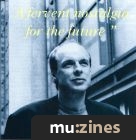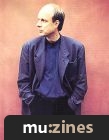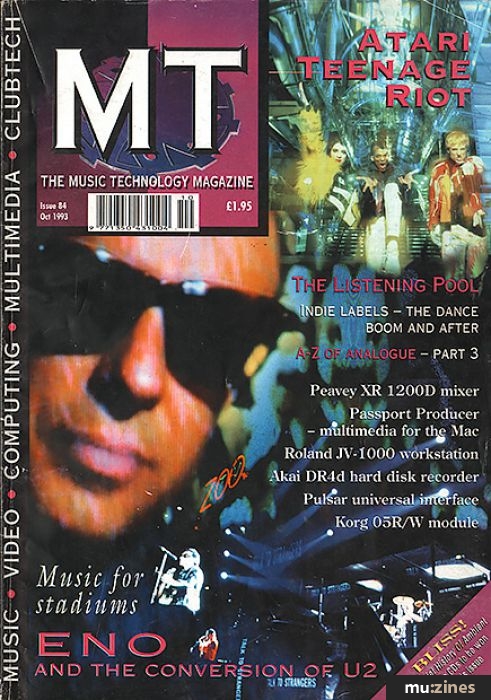Magazine Archive
Home -> Magazines -> Issues -> Articles in this issue -> View
Animal Magic | |
Zoo TV | U2Article from Music Technology, October 1993 | |
MT goes backstage at U2's multimedia spectacular and discovers the technical realities behind Eno and the band's vision. Engineer Dave Lemmink unveils the system that redefines stadium rock
Towards the end of 1991, Brian Eno and U2 discussed plans for a state-of-the-art multimedia stage-set for the band's forthcoming world tour. These plans became Zoo TV, a giant interactive television studio on the road. The UK leg of the tour brought this show to Wembley Stadium, where Phil Ward caught up with U2's video engineer Dave Lemmink to discover how far Eno's vision had become a reality.

The following is an extract from notes made by Brian Eno for Bono following their initial planning meeting for Zoo TV in November, 1991: "The visual aspect of the show should aspire to being as flexible and improvisational as the musical one: it wouldn't suit U2 to be locked into a programmed routine (although it might be OK to do that for certain limited set pieces within the show). The direction ought to be towards flexibility and evolvability and away from locked-in programs. This presents some freedoms and some problems; video is not by nature an improvisational medium".*
He goes on to say: "You don't want to use video just in the ordinary, boring old way - basically only as a means of making the singer look bigger - but you also don't want to produce a show that is just arty, bitty and confusing".*
Almost two years later, what you see as you enter the stadium - and let's not forget that this is a band with a solid stadium rock audience - is a towering set of antennae, 'Digiwalls' and 'Vidiwalls' which resembles a television relay station and an oil refinery in equal measure. Beneath the stage, in an area known as Underworld, a cool eight million dollars worth of video tackle is presided over by Dave Lemmink, chief video engineer and unofficial tour guide. This is the guy who has to make U2's dream actually work, night after night, and his explication is delivered with practised finesse.

"What we have on stage is three giant screens made up of 178 Digiwall cubes, a product developed by a Belgian company that uses European projectors, and which is available in an array that goes up similar to loudspeakers in a large touring environment. The computers are locked underneath one of these. The projectors inside the Digiwalls are your typical 3-gun projectors, like any TV, but modified to project onto a 41-inch screen. We also have an additional four large screens, which are 48 Vidiwall cubes - a Philips product."
Underworld is where all the video imagery used in the show is processed - a combination of live shots of the band on stage and pre-recorded, pre-sequenced events. Video director Monica Caston sits front-of-house and switches between the live cameras which are on stage - four broadcast cameras and a consumer 'Handicam' hand-held by Bono. In addition there are two satellite feeds coming in and two small cameras attached to the drum kit.
"What we do," explains Dave, "is take the live mix that Monica is doing up front, distribute that among the different video walls and intercut with the pre-recorded material. This is stored on ten laser disk players, each one of which holds an hour of material. So during the two and a half hour show you actually watch ten hours of television. Laser disk allows us instant access to any frame or series of frames or sequence on the disk, so it's a very easy random access format. With tape you'd have to cue it forward or back".

And following Eno's brief, random access is essential. "Everyday," reveals Dave, "different songs are added or deleted or changed or moved around in the set. There are about three basic sets that the band does. Plus, they are definitely a live performance band. They are not the type of band that wants to be regulated by a clock or a click-track. So most of the stuff they are playing is actually regulated by the speed that the band goes. It's actually up to the band. What happens is there is a MIDI rig for the backing tracks, but the operator back there has full control, so when the band skips a chorus, adds a verse, he can track with it.
"There are some pre-sequenced songs that are there just because of the visuals that are included with them. For example, 'The Fly' needs to be pretty tightly regulated so that the images come up at the same time. But then there are other songs which are pretty much free form - the B-stage songs for example, which are performed out on the auxiliary stage".
Dave and his colleagues sit three feet below Adam Clayton's bass rig... "so as you can imagine it gets a little loud during the performance," he smiles. "But it allows us real quick access if we ever do have a problem". Here they control what is essentially the insides of an outside broadcast truck, adapted for transport anywhere in the world within 24 hours and heavily protected against the harsh road environment. Included is a control panel for camera brightness and colour levels, standard amplification, monitoring and video effects racks, and record and playback decks for local footage shot at every venue and edited for integration into the show. "These are our video confessionals," Dave says with some relish, "where the audience has a chance to come in and make their 20- second confessional. It can be anything they want..." Shot in a converted portaloo by the mix position during the opening acts, the confessionals are edited together immediately before the show and broadcast before the encore.

The video team also source audio segments from the laser disks, which are mixed on their own audio console before being sent front-of-house. But the real showpiece of Underworld is the computer control of every video sequence. "This is what enables us to access any frame or sequence of frames at the drop of a hat," says Dave. "It's also set up in way that we can sequence a set of visuals - for example, just an ambient loop of, let's say, colour fields going through a spectrum of colours. We can also loop a visual, in which case we have a 7-second set of visuals auto-repeating. Some of Brian Eno's fractal images are looped towards the end of the set...
"This is probably what makes Zoo TV Zoo TV. The computer control has actually evolved over the course of the tour. We originally started with two separate computers to control the video walls, and then a second computer controlling disk players and routers. When we went to the outdoor leg of the United States tour, we had three computers, and added additional large screens. And then finally when we got to Europe here we transferred everything to a Windows-oriented language... so these are actually running on a PC running windows. And it's all custom software that I wrote specifically for the tour.
"It's pretty much a visual sequencer, like the musical sequencers that are available now with MIDI. So we can click on individual screens with the mouse, anywhere on the three large screens or the four Vidiwalls which make up the projection surfaces. We can pick any section of the screen and route an image to that. That way we can have multiple images on each screen. We can break it up to as many squares as these are made of... each one of these squares [on the computer screen] represents one of the Digiwall cubes I showed you earlier. So we've got instant access to all that data, and all on a realtime basis.

"The routing controls allow us to route the 24 primary inputs to the system, those being cameras, laser disks, tape players and satellite feeds. And route those to the different outputs - there are over 200 outputs on the system and at any time any of the inputs can be routed to any of the outputs. So you'll notice that certains songs, like 'The Fly', will have the same thing projected on every screen, as opposed to a song like 'Desire' where you'll see up to seven laser disks running on different screens.
"And down here is our media control page. This is where we actually control the laser disks and tape players. What we can do is assign a frame number so that we can start a particular frame, end at a particular frame, run a sequence, run a loop, just run a segment, stop or freeze on a particular image. All that is pre-programmed in the cues that make up the show. What we do is we build these cues and take the cues and build them into effects. And, what we use effects for is essentially songs, so at any time we can jump from song to song and bring up the associated cues. We also have a SMPTE interface which locks on to the keyboard generating SMPTE time code.
"What happens is The Edge has a MIDI trigger, which starts his MIDI sequencer, which generates SMPTE time code which we lock onto. For certain segments - again, 'The Fly', which is very much a synchronous song - we will lock onto the MIDI song. There's a few other songs where halfway through we'll start a sequence, and it will automatically take over. As soon as the band gets to that section, it will execute those cues. If the band takes their time getting to that section, we're not running graphics early.

"During 'Numb', for example, you'll actually see the visuals in the background, actually taking place and making the noises. A little bit of hardware is involved in this: we carry with us 486-66s, which is really high-tech as far as your personal computers go. The difference is these are all rackmounted in 19-inch racks! It's the same PC you buy in a store, customized for the road. It's truly what we call a visual sequencer, where we can sequence visuals as you would musical sequences".
The sequences themselves, featuring newsreel footage, animation, graphics and a kaleidoscopic montage of television imagery, were produced by Ned O'Hanlon and directed by Maurice Linnane, in conjunction with a number of producers from MTV and Brian Eno himself. The challenge, from the beginning, was to find the technological means to express visual and musical ideas in a flux, one which necessarily takes account of both the chaos of media culture and the improvisational give and take of a rock band. The solutions, courtesy of Dave Lemmink and his team, do more than meet this challenge: they offer a blueprint for interactive, multimedia expression that could serve a whole generation.
* extracts courtesy of Opal Information Number 21, published by Opal Ltd., PO Box 141, Leigh-on-Sea, Essex.
Zoology
Two IBM-compatible 486DX2 66mHz computers:
8Mb RAM
240Mb HDD
28 serial ports (three Arnet multiport cards)
Maxstone multimonitor card
Four VGA monitors
For-A CVM600 component production switcher
Grass Valley 20-TEN series routing
BTS TAS/TVS series routing
Grass Valley video transcoding, encoding and distribution
Eleven Pioneer LDV8000 video disc players
Two Sony 9800 series three-quarter-inch SP tape decks
Two Sony BVW series Betacam SP tape decks
Four Ikegami HL-55A Broadcast chip cameras and CCUs
Two Sony Handicams (known on this tour as 'Bonocams')
Four Sony lipstick cameras
Two satellite receivers
Magni and Tektronix test equipment
Sony and Ikegami production and preview monitors
Projection equipment
Three Digiwalls, made up of 41" diagonal Digiwall projection cubes
screen 1: 14 cubes high by 6 cubes wide
screen 2: 9-high by 5-wide
screen 3: 7-wide by 7-high
Four onstage Vidiwalls
all walls 4 cubes high by 3 cubes wide
36 Barco 27" monitors
More with this artist
Electric Fire (U2) |
U2 - can have an Edge like this (U2) |
U2: The Unforgettable Tour (U2) |
More from related artists
The Life Of Brian (Brian Eno) (Part 1) |
The Life Of Brian (Brian Eno) (Part 2) |
Heroes (Brian Eno) (Part 12) |
Electric Fire (Daniel Lanois) |
U2 - can have an Edge like this (The Edge) |
Edgeways (The Edge) |
Creating Chaos (Daniel Lanois) |
Eno Sense (Brian Eno) |
Adam Clayton (Adam Clayton) |
Daniel Lanois - Visions of Arcadia (Daniel Lanois) |
Brian Eno - Breaking The Silence (Brian Eno) |
Discretion (Brian Eno) |
from Jams to James (Brian Eno) |
More with this topic
 Lingo Stars - Foreign phrases for tour survival |
Live End - 808 Statement |
Sounds good, John |
Tuned in & Turned on - In-Ear Monitoring Enlightenment |
Control Zones - The Case For Master Keyboards |
What's What |
Into the Music |
Superstar - Behind The Scenes At The Lyceum |
Knebworth Goes Supersonic - Oasis On Stage |
PA Column |
Access all areas - Glastonbury sound |
 The Pursuit of Dollars - Touring In America |
Browse by Topic:
Live
Publisher: Music Technology - Music Maker Publications (UK), Future Publishing.
The current copyright owner/s of this content may differ from the originally published copyright notice.
More details on copyright ownership...
Feature by Phil Ward
Help Support The Things You Love
mu:zines is the result of thousands of hours of effort, and will require many thousands more going forward to reach our goals of getting all this content online.
If you value this resource, you can support this project - it really helps!
Donations for October 2025
Issues donated this month: 0
New issues that have been donated or scanned for us this month.
Funds donated this month: £0.00
All donations and support are gratefully appreciated - thank you.
Magazines Needed - Can You Help?
Do you have any of these magazine issues?
If so, and you can donate, lend or scan them to help complete our archive, please get in touch via the Contribute page - thanks!

































